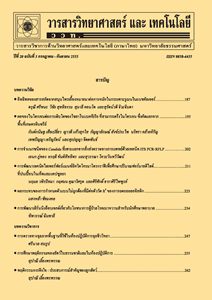การนำแก้วขวดโซดาและเถ้าหนักปาล์มน้ำมันมาใช้ประโยชน์ในการผลิตแก้วเซรามิก
Main Article Content
Abstract
บทคัดย่อ
เถ้าหนักของเสียจากการเผาไหม้เศษวัสดุปาล์มน้ำมันในโรงงานผลิตน้ำมันปาล์ม ซึ่งมีองค์ประกอบซิลิกา อะลูมินา และเหล็กสูง ใช้ผสมร่วมกับแก้วขวดโซดาเพื่อศึกษาผลกระทบของการเปลี่ยนสภาพแก้วต่อตัวอย่างแก้วเซรามิก วัตถุดิบทั้งเถ้าหนักและเศษแก้วขวดโซดานำไปบดด้วยเครื่องบดแบบลูกบอลกระแทก เป็นเวลา 3 ชั่วโมง จากนั้นนำมาคัดขนาดให้อนุภาคเล็กกว่า 75 ไมครอน เถ้าหนักแทนที่เศษแก้วขวดโซดาด้วยอัตราส่วนร้อยละ 20, 30, 40 และ 50 โดยน้ำหนัก อัดขึ้นรูปเบ้าตัวอย่างเส้นผ่านศูนย์กลาง 15 มิลลิเมตร และยาว 17 มิลลิเมตร ภายใต้แรงอัดแกนเดียว 50 เมกะพาสคัล และเผาที่อุณหภูมิในช่วง 750 ถึง 950 องศาเซลเซียส ค้างไว้เป็นเวลาหนึ่งชั่วโมง ตัวอย่างทดสอบทั้งสมบัติทางกายภาพและทางกล ได้แก่ ความหนาแน่น การดูดซึมน้ำ การหดตัวหลังเผาเชิงปริมาตร ความแข็งแบบชอร์ กำลังอัดที่อุณหภูมิทั่วไปและที่ 100 องศาเซลเซียส นอกจากนี้ยังทดสอบความคงทนต่อสารเคมีและการเปลี่ยนอุณหภูมิอย่างฉับพลัน เลือกตัวอย่างวิเคราะห์แร่ประกอบและโครงสร้างจุลภาคด้วยการเลี้ยวเบนรังสีเอกซ์และกล้องจุลทรรศน์อิเล็กตรอนแบบส่องกราดตามลำดับ ผลการทดสอบพบว่าตัวอย่างที่ให้โดดเด่นคือใส่เถ้าหนักร้อยละ 30 เผาที่อุณหภูมิ 850 องศาเซลเซียส ผลวิเคราะห์การเลี้ยวเบนรังสีเอกซ์ได้ปรากฏวัฏภาคของแร่สำคัญ คือ โวลลาสโทไนต์ ไดออปไซด์ และคริสโทบาไลต์ ภาพถ่ายจุลทรรศน์อิเล็กตรอนแบบส่องกราดแสดงลักษณะคล้ายรูปเข็มของโวลลาสโทไนต์และรอยโค้งเว้ารูปฝาหอยของขอบรูโพรงคริสโทบาไลต์
คำสำคัญ : แก้วเซรามิก; เถ้าหนักปาล์มน้ำมัน; แก้วขวดโซดา; การเผาผนึก; การเปลี่ยนสภาพแก้ว
Abstract
Oil palm bottom ash (OPBA) which is a pollutant residue from fuel in a palm oil factory consisting high silica, alumina and iron was incorporated with soda bottle glass (SBG) to study vitrification effects on the fired glass-ceramics specimens. Both raw materials were ground by ball mill for 3 hours, and then were sieved to the particle size lesser than 75 microns. OPBA was replaced partially in different proportions of 20, 30, 40 and 50 wt. %. Cylindrical specimens (15 mm in diameter and 17 mm in length) were formed under uniaxial pressure of 283 MPa and fired at temperatures ranging from 750 to 950 °C with the soaking time of one hour. Properties of specimen which are bulk density, water absorption, volumetric shrinkage, Shore hardness, and compressive strengths at ambient temperature and at 100ºC were determined. In addition, chemical resistance and thermal shock tests were also performed. Mineral compositions and microstructures of the selected specimen were analysed by X-ray diffraction and scanning electron microscope, respectively. The experimental result indicated that the outstanding specimen is 30 % OPBA with heat treatment at 850 °C. XRD pattern revealed the presence of wollastonite, diopside and cristobalite, as major crystalline phase. SEM microphotography was characterized by the presence of needle like wollastonite crystal and conchoidral fracture of cristobalite pores.
Keywords: glass ceramic; oil palm bottom ash; soda bottle glass; sintering; vitrification


